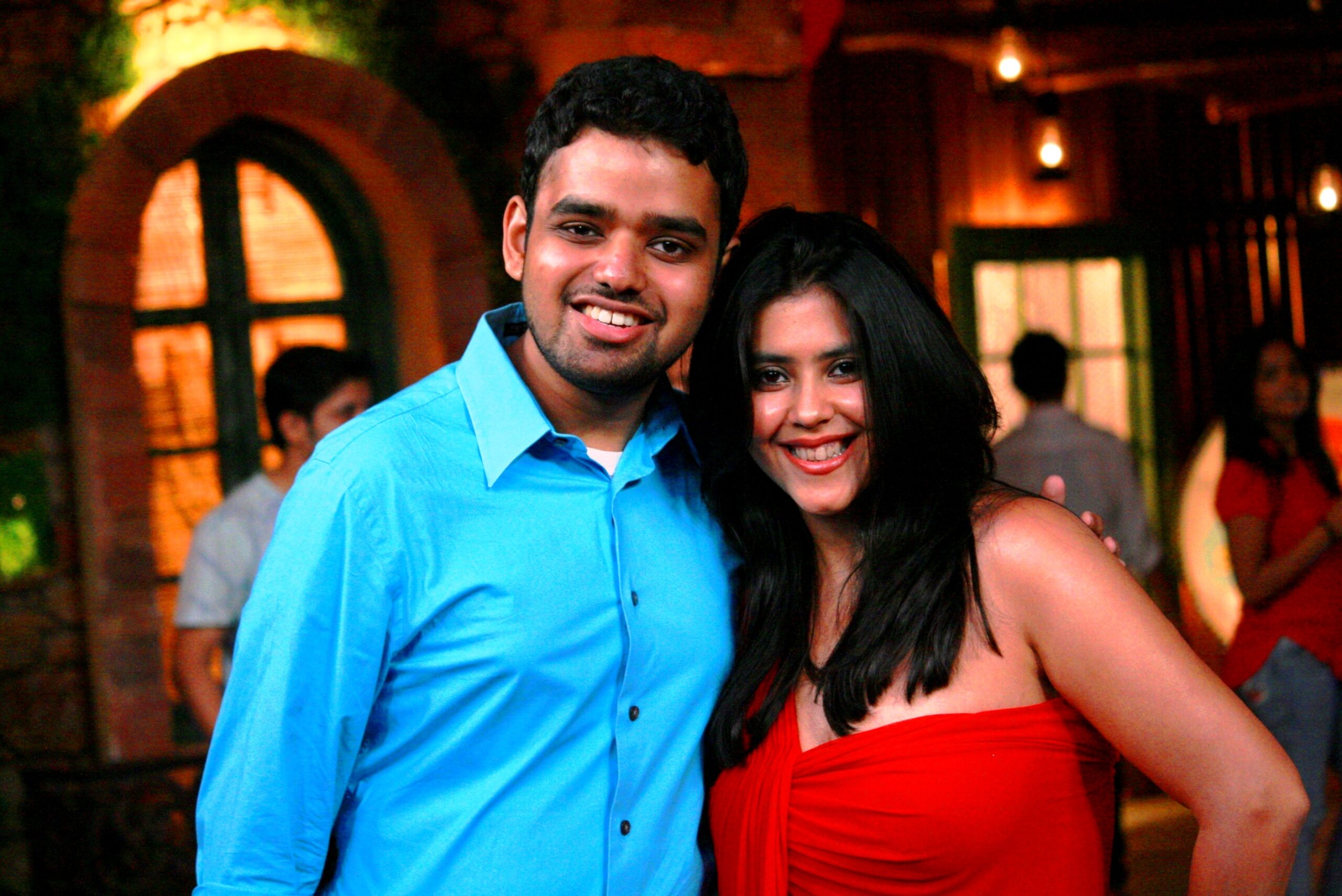Working in the soap factory!
Sharing an excerpt from ‘Kingdom of the Soap Queen, a book I had the privilege of authoring while working at Balaji Telefilms!
Two wrought iron gates swing wide open to a compound. As you take a few steps inside, you are flabbergasted by the visual. Several men and women draped in milk white clothing are mourning with tears flowing from their eyes. Four sturdy men lift a stretcher with the support of their strong shoulders. The dead body of a young man lies straight with sandalwood paste applied on his forehead. A few basil leaves lie to the right side of the corpse and the stretcher is decorated with marigolds, roses, and daises. The men begin to walk away from the congregation while chanting the holy name of Lord Rama. Meanwhile, the women continue to weep in the background. The deceased man’s widow breaks down and falls to the floor. There is remorse and despair everywhere. Although the dead man is an unknown entity in your life, you cannot help but shed a tear as well in this highly emotional atmosphere.
Suddenly a bearded man sitting in a director’s chair yells “cut!” A giant jimmy jib portable crane in the middle of the air with a camera perched at the top swings back to the ground. Spot boys hurry to the field and touch up the make-up of various actors. A few women use this time to reapply glycerin below their eyelids while the men take their mid-day tea break. The dead man also comes alive and entertains his fans who have been patiently waiting to take a picture.
As you make your way through the myriad of mourners, a pristine marble temple catches your sight. The temple houses an idol of Goddess Durga, the ultimate Hindu representation of female power and supremacy. Your thoughts are suddenly interjected as a new set of camera crew scurries towards the shrine. Alongside paces a stunning actress decked in a heavy Kanjeevaram saree and gold jewelry. She has clutched a script and is mugging up dialogues rapidly. Massive lights are set up around the temple and it magically transforms into a shooting location. The executive producer gives a briefing to the heroine and begs that she wind-up the scene quickly as the episode has to air the following day. As the camera rolls, the woman violently bangs the bells of the temple and pleads the goddess to give her strength and willpower.
You now take a turn from the holy place and see a colossal seven-storey building smiling down at you. The edifice has something enchanting about it. Like Cinderella’s fairy tale castle in the heart of Walt Disney World, this superstructure has a miraculous nature to it. The seven stories seem to endlessly blend with the pink and blue sky that envelops the horizon, and a trail of pixie dust leads your way as you inch closer to the structure.
Kahaani Ghar Ghar Kii | Balaji House 5th Floor | 9 am to 9 pm |
Kalash | Balaji House 4th Floor | 12 pm to 12 am |
Kabhii Sautan Kabhii Sahelii | Balaji House Ground Floor | 9 am to 10 pm |
Kaahin Kissii Roz | Film City | 2 pm to 2 am |
Kyunki Saas Bhi Kabhi Bahu Thi | Balaji Studio I | 9 am to 10 pm |
Kasautii Zindagii Kay | Balaji Studio III | 7 am to 1 pm |
Kammal | Balaji Studio III | 2 pm to 2 am |
Kkusum | Balaji Studio IV | 9 am to 2 pm |
Kutumb | Balaji Studio V | 9 am to 9 pm |
Kohi Apna Sa | Balaji Studio II | 12 pm to 12 am |
A shiny dry erase board is pinned to the mammoth construction. On the board, the following is scribbled a bright blue colored marker:
The board indicates Balaji’s packed shooting schedule for the entire day. And if it looks intense, it most certainly is. Ten serials need to shot in the next 24 hours. Each serial needs to chalk out at least one episode’s footage, around 20 minutes of recording. The lump sum for all of the programs equals 3.5 hours of material, a length greater than most motion pictures. All of this has to be completed within the allotted time as the stakes are incredibly high.
The situation is complicated by other factors. For starters, quite a few serials have overlapping cast members. Artistes may often find themselves playing pivotal roles in up to three serials at a time. They shuffle between the sets, popping in and out of the characters as quickly as they change their getups. Scenes are accordingly scheduled to mix and match the availability of performers based on the serials they act in. To fuel the state of affairs, majority of the programs do not have a bank of episodes ready. Several of the episodes currently getting shot may air on television the following night, tonight, or even in a few hours.
As you journey your way into the building, you find yourself in the middle of what is nothing less than an entertainment manufacturing plant. On one floor a screenwriter is rapidly jamming his fingers on a computer keyboard. He is wrapping up a scene that is urgently needed for shooting on the sets. On another floor, an editor is quickly transforming 10 hours of shoot footage into a compressed 20 minute episode. In another cranny, a singer is mouthing away a background melody into a microphone. On the staircase, a creative head is hurriedly darting up and down to ensure her show’s cassette reaches the channel on time for telecast.
An entire world manifests itself under the roof of this humungous architecture. More formally known as Balaji House, this is the creative sanctuary and headquarters of Balaji Telefilms Limited.
In 1994, Jeetendra purchased a handsome-looking plot in the heart of Andheri West along with Sri Adhikari Brothers. The plot was bought with the intent of building an office space that could be leased to external businesses. Work on this building began rather quickly, only to be halted by the 1995 mega-crash in real estate. The Adhikaris had been riding the success wave in the entertainment world. For them, holding onto their quarter share of this unfinished building did not seem of value. The Adhikaris moved away from the project and had their own office building built. This, in turn, left the Kapoor family perplexed on how to use the uncompleted building. There was zero capital to finish the structure, as all of the family’s savings had been pumped into Balaji Telefilms.
Meanwhile, in spite of the success that Balaji had recently witnessed, the company’s money had not been compounding. Enough profit was rolling in to create new shows, but not as much as Shobha and Ekta needed to sustain their business and expand it. The mother and daughter frequently found themselves in a hand-to-mouth situationA step towards the next level seemed almost unattainable; the much needed monetary push was missing.
At this point, Shobha consulted her astrologer for guidance. The clairvoyant’s advice, though simple, was hard-hitting. He warned Shobha that if she continued to conduct her commerce from the basement of her bungalow, it would not blossom. Working from beneath the Earth would sustain the business, but would not nurture it. The garage was a logical space for accounting work or storage, but not for the action of the trade. Analogous to a green leafy plant, Balaji could solidify its roots under the earth, but its transformation into an orchard would only take place once it exposed itself to sunlight. If the women truly wanted to earn big bucks, they would have to leave their underground lagoon and come on top of the soil.
Jeetendra’s Andheri-purchased office building was halfway complete at this juncture. Shobha took one sharp look at it from top to bottom and determined that this would be the new office of her company. With her goodwill in the industry, Shobha took a massive bank loan in 1999 and had the building finished in 2000. The construction was furnished with marble, flooring, steps, elevators, furniture, and air conditioning. Members of the Balaji team would no longer have to argue over the few available steel tables in the basement of Krishna Bungalow. They would now have ample space with desks of their own to conduct their work efficiently.
The budding producers were determined to make the best use of the new building. The first floor was used for Shobha and Ekta’s cabins accompanied with office space for creative heads and writers. The second floor was Jeetendra’s cabin and accounts, while the third floor housed editing studios. The basement, ground, fourth and fifth floors, meanwhile, were converted into sets to fulfill shooting purposes. The entire company’s operations were finally gathered in one central location.





